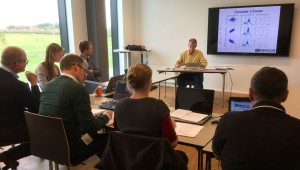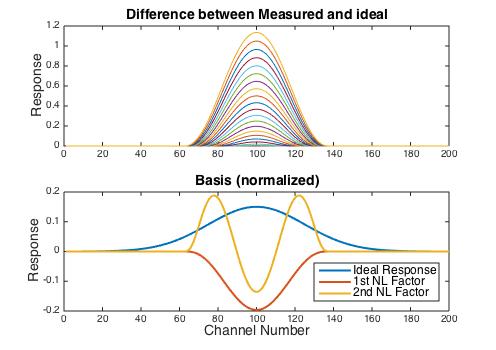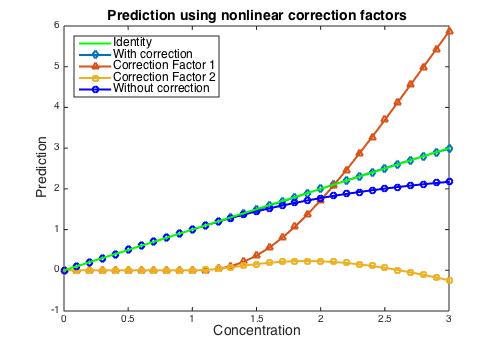Category Archives: Short Courses
EigenU 2025 Wrap-up
May 17, 2025
The 19th Eigenvector University wrapped up on Friday, May 16. A little smaller this year, we had 32 students from locations as far away as Milan, Italy and Santiago, Chile. EigenU 2025 started with online classes the week before including the new “Introduction to PLS_Toolbox and Solo” developed by our Lyle Lawrence. In person classes started Monday, May 12 at the Washington Athletic Club in Seattle with “Chemometrics I: Principal Components Analysis.” This year Neal Gallagher and I covered the teaching duties for this class on PCA, arguably the most important method in modern data science. And in spite of the fact that I’ve taught this 100+ times over 30+ years I’m still enthusiastic to do so. PCA is just so useful and the insights gained from it are often significant, and, well, it’s just fun to see what’s in data sets!
The rest of the EVRI staff caught up with us on Monday evening. As always, EigenU is an opportunity for us to get together and we enjoyed a nice dinner at Tulio on Tuesday (below). This is a rare photo in that it includes Jill, my spouse and the person that runs the Eigenvector “back office.” It is always great to have the whole crew together!

Eigenvector staff including (from left) Lyle Lawrence, Manny Palacios, Barry Wise, Jill Wise, Scott Koch, Nate Watson, Donal O’Sullivan and Bob Roginski.
Wednesday night we were at the Top of the WAC with the “PowerUser Tips & Tricks” session where the EigenGuys take turns presenting their favorite underutilized or new software feature. Also the “PLS_Toolbox/Solo User Poster Session” was held, where users get to share analyses they’ve been working on. This year’s best poster winners were Shirmir Branch with “Using PLS_Toolbox for the Analysis of Complex Molten Salt Chemistry” and Benjamin Panitz with “Development of a Chemometrics Model for Rapid Fish Egg Quality Assessment in Aquaculture.” Both of these posters addressed really interesting issues. Shirmir’s involved developing methodology to monitor metals including radioactive elements in the molten salt cooling system in nuclear reactors. The problem of selecting optimal fish eggs for production in hatcheries. Shirmir and Ben took home Bose SoundLink Bluetooth Speakers for their efforts!

Eigenvector Research Vice-President Neal B. Gallagher presenting Shirmir Branch with the prize for her winning poster.
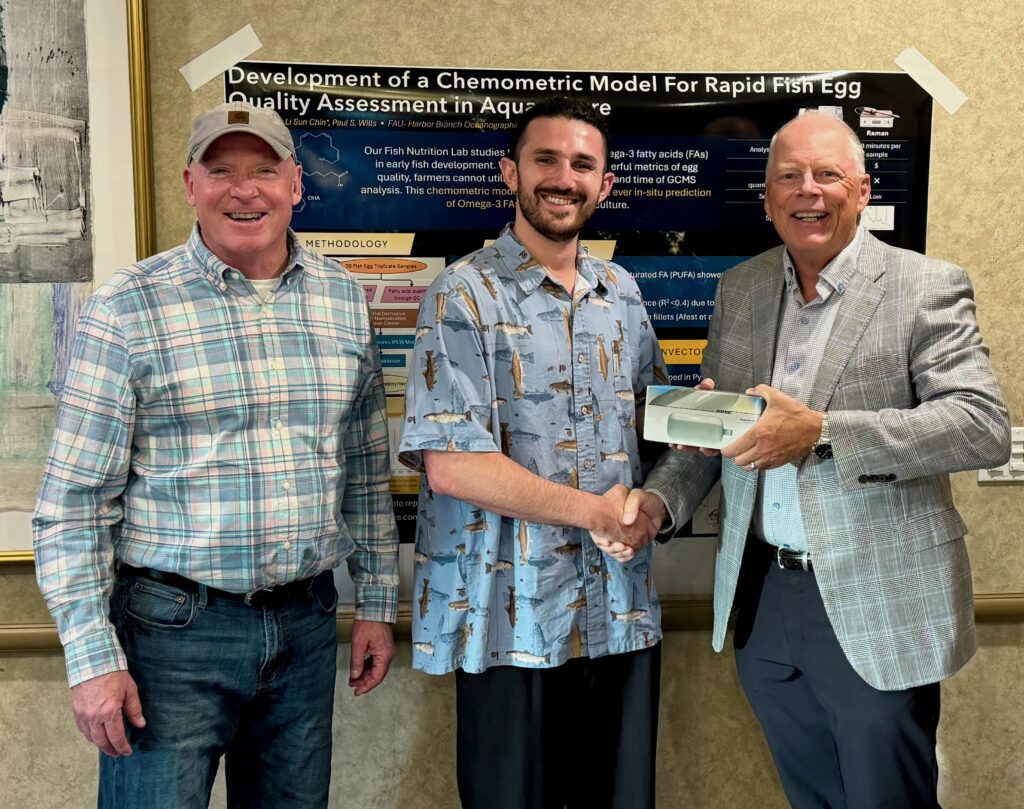
Eigenvector Research President Barry M. Wise presenting Benjamin Panitz with a prize for his winning poster.
Professor Rasmus Bro joined us again this year, teaching several classes including the new “PLS_Toolbox from the Command Line.” If you want to learn how to automate analyses or make them run sans interfaces this is the place to start. We’ve found that most of our experienced PLS_Toolbox users use a mix of interfaces and command line, as do we in our roles as consultants. It is a very powerful combination!
EigenU 2025 concluded with Thursday evening’s workshop dinner, this year in Haggerty’s Sports Bar, and Friday’s “Non-linear Machine Learning for Calibration and Classification.” In all sixteen hands-on classes in chemometrics and machine learning were presented along with the two evening events. A very busy week for sure! We wish all our students the best of luck as they employ their new data science skills back at home.
BMW
In-Person, Live Online or Recorded?
Sep 25, 2023
At Eigenvector Research we offer many courses in chemometrics and machine learning and several ways to take them. As such, I often get variations on the question “what’s the difference between your in-person classes and your online classes?”
I’ll address this by starting with what stays the same. We use the same notes, and have the same instructors. For the most part we use the same data sets and go over the same examples hands-on with our PLS_Toolbox/Solo software. And we spend approximately the same amount of time on each topic.
So what’s the difference? At the risk of sounding condescending, the main difference is that you attend our in-person classes in person and with the online options you don’t. But the in-person aspect brings many unique possibilities with it. The most important one is the student-teacher interaction. In a live class the instructors can answer questions in real time, and also observe the students and sense if they are “getting it” or not. For the hands-on parts, we also usually have one or more additional instructors walking around behind people to see what’s on their screen to check that they are following and assist if necessary.
With in-person classes you also have the time at breaks and after class to talk face to face, like our Manny Palacios at left below discussing aspects of regression with an EigenU attendee. Plus there are also opportunities to interact, network and socialize with fellow attendees. Beyond this, in-person classes force you to set aside time, focus on learning and take advantage of the immersive environment.
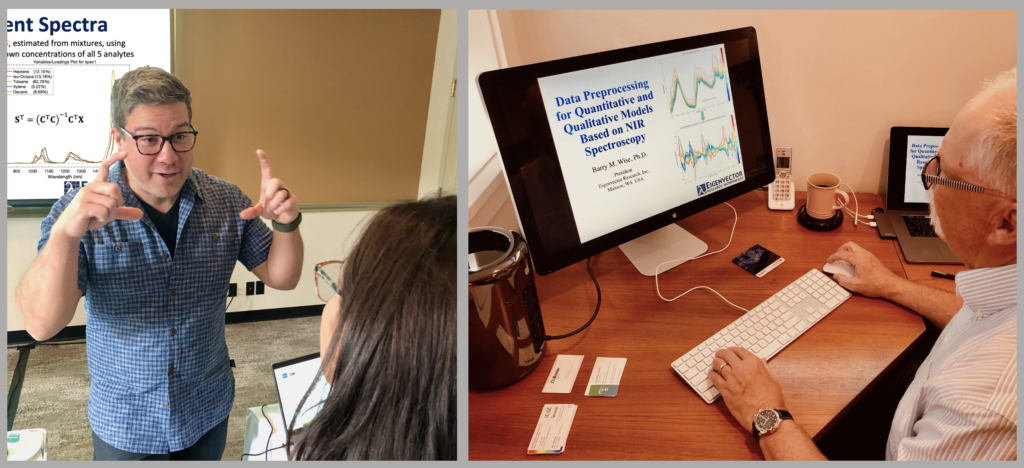
The downside of in-person classes? Time and expense. You have to block the time off for the class plus the travel time. Unless the courses are nearby there are travel and lodging expenses and the courses themselves cost more.
For remote learning, we offer classes both live online and recorded online. The live online classes are at scheduled times, generally early morning in North America and late afternoon in Europe. Students can ask questions that the instructor can answer as part of the lecture or his assistants can answer through online chat. Plus we record these so students can review them later, which is especially helpful with the hands-on exercises. But of course the student-teacher interaction doesn’t match what possible in person, and there is not much interaction between students. And like in-person classes, you might not find the class you want in the time frame you need it. Online classes are, however, much less expensive and can be done from the comfort of your home or office, like the guy on the right above (whose desk hasn’t been this clean since the picture was taken 3 years ago).
Finally, there are recorded online classes. The main advantage of these is that they can be done completely on your own schedule, are available on demand, and like live online classes, are less expensive and don’t require travel. They do, however, put more distance between instructors and students as they become separated in both space and time! Questions are answered via email but not in real time.
In-person vs. Live Online vs. Recorded Online Pros and Cons
| Pros | Cons | |
|---|---|---|
| In-person Classes | Best student-teacher interaction | Most expensive |
| Real-time answers to questions | Added travel time | |
| Interactions with fellow students | Time away from office | |
| Forces focus on learning | ||
| After class & social opportunities | ||
| Live Online Classes | Real time answers to questions | Less student-teacher interaction |
| Access to recordings for review | No interaction with fellow students | |
| Forces setting time aside | No after class & social | |
| Less expensive | ||
| No travel required | ||
| Recorded Online Classes | Learn at your own pace | Least amount of student-teacher interaction |
| Available on demand | No interaction with fellow students | |
| Less expensive | No after class & social | |
| No travel required | Easy to put off |
So what to choose? I’ve listed the pros and cons as I see them in the table above. Different people learn differently, so what’s a pro to one may be a con to another. For some, like me, attending something live forces me to set aside time then pay attention, e.g. turn off my phone and email, until it’s over. Some people don’t consider this an advantage!
That said, IMHO, if you can afford the time and expense and can work them into your schedule, in-person short courses are the best way to get started with a new subject in the shortest amount of time. They are the Cadillac (or in my case the Lincoln) way to learn. Between live online and recorded online I’d choose live if you can find the right course at the right time. But if you need it and have to have it right now, you can’t beat recorded online for on demand convenience.
Happy learning!
BMW
For more thoughts about teaching chemometrics please see: Wise, Barry M., Teaching Chemometrics in Short Course Format, J. Chemometrics, 36(5), April 2022.
Chemometrics without Equations
Nov 29, 2022
In 1988 Donald Dahlberg, Professor of Chemistry at Lebanon Valley College (LVC), decided to take a sabbatical leave at the University of Washington (UW) Center for Process Analytical Chemistry (CPAC). At the time, his former student Mary Beth Seasholtz was a second year graduate student in Bruce Kowalski’s Laboratory for Chemometrics. Mary Beth asked Don if he’d be interested in seeing what she was doing. Before Don knew it, he was attending Kowalski’s chemometrics courses and group meetings. I met Don during this period as I was also at CPAC.
When he returned to LVC he started teaching chemometrics to undergraduate students, and involving them in research. This included collaborative research with a local confectionary company.
Meanwhile, at Eigenvector we were interested in developing chemometrics courses for a wider audience. So sometime in 2001 our Neal B. Gallagher contacted Don about the possibility of creating a chemometrics workshop that did not involve the parallel presentation of matrix algebra. They struggled over a title, but eventually settled on “Chemometics without Equations (or hardly any).” We call it CWE for short. Don, having recently retired from teaching at LVC, wrote the workshop with Neal reviewing the content.

Don and Neal first presented CWE at the 16th International Forum on Process Analytical Chemistry (IFPAC) in San Diego on January 21-22, 2002. The course was taught hands-on using PLS_Toolbox. CWE was repeated at CPAC’s Summer Institute that July and again at the Federation of Analytical Chemistry and Spectroscopy Societies (FACSS, now SCIX) conference in October 2022 in Ft. Lauderdale, FL. This marked the beginning of CWE’s 20 year run at fall conferences. It was repeated in 2003 at FACSS and in 2004 moved to the Eastern Analytical Symposium (EAS), its home through this year. The workshop has been offered every year, except in 2020 when COVID-19 prevented a physical conference.
EAS 2022 marks Don’s final presentation of the course at EAS, making a total of 20 fall conference appearances. Each time Don has been assisted by either Neal or myself. Knowing that Don was an avid bourbon connoisseur we commemorated the occasion with a bottle of Blanton’s as he completed his final class.
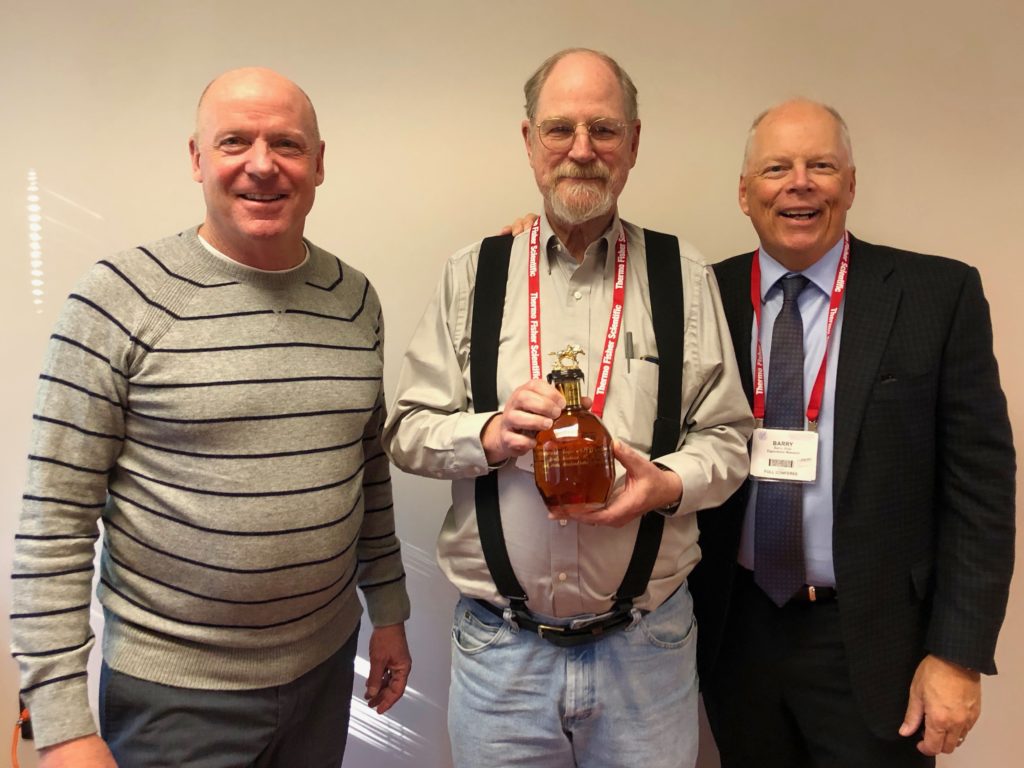
Looking back on 20 years of teaching CWE Don observed:
EAS has allowed me to meet many scientist who wish to learn and use chemometrics. They have included not only scientists in chemistry, but also those in related fields such as forensic science and cultural heritage. I have had the privilege to offer special versions of the course, tailored to the latter two fields. I have been able to present the course at John Jay College of Criminal Justice, the Forensic Science Department at the University of New Haven, the Museum of Modern Art, the Getty Museum and the Library of Congress. My goal has been to introduce the power of chemometrics to those inside and outside of analytical chemistry. Even though it is time to end my presentations at EAS, I intend to continue to help those who wish to explore the field of chemometrics.
Over 20+ years Professor Dahlberg has gently introduced hundreds to the field of chemometrics with CWE taught at conferences, at in-house classes and online. Thanks Don for your service to field! Cheers and bottoms up!
If you’d like to have Chemometrics without Equations presented at your site, please write bmw@eigenvector.com and we’ll help you arrange it.
We used to call it “Chemometrics”
Feb 23, 2022
The term chemometrics was coined by Svante Wold in a grant application he submitted in 1971 while at the University of Umeå. Supposedly, he thought that creating a new term, (in Swedish it is ‘kemometri’), would increase the likelihood of his application being funded. In 1974, while on a visit to the University of Washington, Svante and Bruce Kowalski founded the International Chemometrics Society over dinner at the Casa Lupita Mexican restaurant. I’d guess that margaritas were involved. (Fun fact: I lived just a block from Casa Lupita in the late 70s and 80s.)

Chemometrics is a good word. The “chemo” part of course refers to chemistry and “metrics” indicates that it is a measurement science: a metric is a meaningful measurement taken over a period of time that communicates vital information about a process or activity, leading to fact-based decisions. Chemometrics is therefore measurement science in the area of chemical applications. Many other fields have their metrics: econometrics, psychometrics, biometrics. Chemical data is also generated in many other fields including biology, biochemistry, medicine and chemical engineering.
So chemometrics is defined as the chemical discipline that uses mathematical, statistical, and other methods employing formal logic to design or select optimal measurement procedures and experiments, and to provide maximum relevant chemical information by analyzing chemical data.
In spite of being a nearly perfect word to capture what we do here at Eigenvector, there are two significant problems encountered when using the term Chemometrics: 1) In spite of the existence of the field for nearly five decades and two dedicated journals (Journal of Chemometrics and Chemometrics and Intelligent Laboratory Systems), the term is not widely known. I still run into graduates of chemistry programs who have never heard the term, and of course it is even less well known in the related disciplines, and less yet in the general population. 2) Many that are familiar with the term think it refers to a collection of primarily projection methods, (e.g. Principal Components Analysis (PCA), Partial Least Squares Regression (PLS)), and therefore other Machine Learning (ML) methods (e.g. Artificial Neural Networks (ANN), Support Vector Machines (SVM)) are not chemometrics regardless of where they are applied. Problem number 2 is exacerbated by the current Artificial Intelligence (AI) buzz and the proclivity of managers and executives towards things that are new and shiny: “We have to start using AI!”

This wouldn’t matter much if choosing the right terms wasn’t so critical to being found. Search engines pretty much deliver what was asked for. So you have to be sure you are using terms that are actually being searched on. So what to use?
A common definition of artificial intelligence is the theory and development of computer systems able to perform tasks that normally require human intelligence. This is a rather low bar. Many of the models we develop make better predictions than humans could to begin with. But AI is generally associated with problems such as visual perception and speech recognition, things that humans are particularly adept at. These AI applications generally require very complex deep neural networks etc. And so while you could say we do AI this feels like too much hyperbole, and certainly there are other arguments against using this term loosely.
Machine learning is the use and development of computer systems that are able to learn and adapt without following explicit instructions, by using algorithms and statistical models to analyze and draw inferences from patterns in data. Most researchers (apparently) view ML as a subset of AI. Do a search on “artificial intelligence machine learning images” and you’ll find many Venn diagrams illustrating this. I tend to see it as the other way around: AI is the subset of ML that uses complex models to address problems like visual perception. I’ve always had a problem with the term “learning” as it anthropomorphizes data models: they don’t learn, they are parameterized! (If these models really do learn I’m forced to conclude that I’m just a machine made out of meat.) In any case, models from Principal Components Regression (PCR) through XGBoost are commonly considered ML models, so certainly the term machine learning applies to our software.
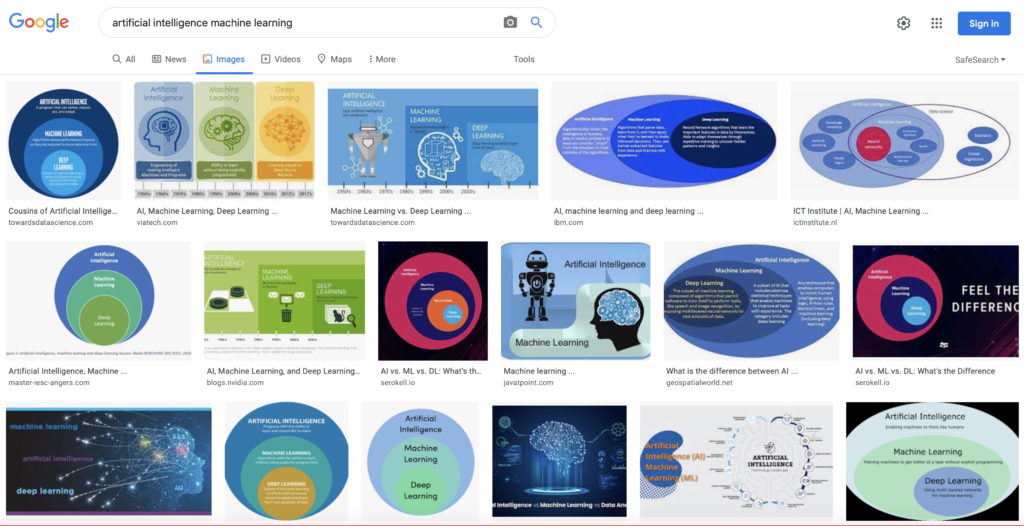
Process analytics is a much less used term and particular to chemical process data modeling and analysis. There are however conferences and research centers that use this term in their name, e.g. IFPAC, APACT and CPACT. Cheminformatics sounds relevant to what we do but in fact the term refers to the use of physical chemistry theory with computer and information science techniques in order to predict the properties and interactions of chemicals.
Data science is defined as the field that uses scientific methods, processes, algorithms and systems to extract knowledge and insights from data. Certainly this is what we do at Eigenvector, but of course primarily in chemistry/chemical engineering where we have a great deal of specific domain knowledge such as the fundamentals of spectroscopy, chemical processes, etc. Thus the term chemical data science describes us pretty well.
So you will find that we will use the terms Machine Learning and Chemical Data Science a lot in the future though we certainly will continue to do Chemometrics!
BMW
COVID-19 Upate: Still Here to Help You
Mar 18, 2020
As with most of you, we here at Eigenvector are very concerned about the COVID-19 outbreak and its impact on our families, friends, customers and communities. We continue to monitor its evolution closely, especially in regard to our employees and their families. The direct effect of COVID-19 on the daily business of Eigenvector, however, is modest. For over 25 years now everybody, or as we say, EVRIbody in our organization has worked from home. We’re all set up to work remotely as that is how we’ve always done it. We expect to be working our usual hours for the foreseeable future with perhaps a few exceptions to work with and around spouses, children and parents now occupying our homes or needing our assistance.
We recognize that many of our colleagues are experiencing work disruptions and many are now working from home. As experienced home workers we offer here a few tips for making your home office productive and keeping your work/life balance intact.
- Start early and try to work regular hours.
- Shower, shave and dress as if you were going to the office. (The EigenGuys aren’t very good at this, especially the shaving part.)
- If you have a monitor get the level correct and set your keyboard up in a way that supports your wrists.
- Get a good chair and resist the urge to work in places that don’t promote good posture.
- A headset with noise cancellation and a good microphone is useful for Webex meetings, conference calls, regular phone calls and simply screening out distractions.
- Check in with co-workers frequently.
- Plan some time for exercise even if it’s just a walk around the block or some stretching and sets of sit-ups and push-ups. I like mid-morning for this.
- Try to stay out of the kitchen (this is tough) unless you’re using your break time to start long prep time meals (crock-pot, pizza dough, etc.).
- Set a “closing time” and try to stick to it. Spouses/partners can enforce this by setting a beer on the homeworker’s desk at the appointed time. (This always works on me!)
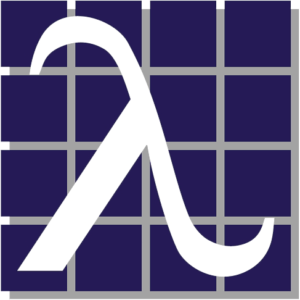 Many of our software users are among these new homeworkers and we are working to accommodate them. In particular, users that work with our floating license versions of PLS_Toolbox or Solo may have trouble reaching EVRI’s Floating License Server when working from home. We have just posted a video addressing this issue: Using Floating License Software Remotely. As always, if you have any questions regarding our software or online courses please contact our helpdesk and we will respond promptly. And to our consulting clients: we are available as always.
Many of our software users are among these new homeworkers and we are working to accommodate them. In particular, users that work with our floating license versions of PLS_Toolbox or Solo may have trouble reaching EVRI’s Floating License Server when working from home. We have just posted a video addressing this issue: Using Floating License Software Remotely. As always, if you have any questions regarding our software or online courses please contact our helpdesk and we will respond promptly. And to our consulting clients: we are available as always.
Our 15th Annual Eigenvector University, originally scheduled for April 26-May 1, has been postponed until August 16-21. We will of course continue to monitor the situation to determine if additional delays are warranted.
Finally, we also have plans to offer additional resources online. We will step up the frequency of our “EVRI-thing You Need to Know About..” webinar series to twice per month. The next one, “EVRI-thing You Need to Know About Performing PLS-DA” is Wednesday, March 25 at 8:00 am PDT, (16:00 CET). We also plan to offer a couple of our short courses via webinar in the coming months. We will let you know when plans are finalized.
Above all, stay healthy!
BMW
EigenU 2018 Poster Winners
May 29, 2018
The 13th Annual Eigenvector University was held April 29-May 4 in Seattle. It was a busy, vibrant week with 40 students with a wide variety of backgrounds attending along with 10 instructors. Users of our PLS_Toolbox and Solo chemometrics packages showed some of their recent results at the Wednesday evening poster session, which has become an EigenU tradition. Now combined with our PowerUser Tips & Tricks session, it makes for a full evening of scientific and technical exchange fueled by hors d’oeuvres and adult beverages.
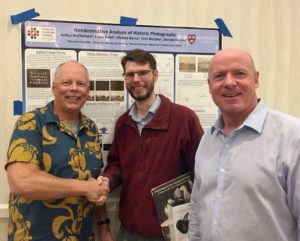
This year’s best poster, (as judged by the EVRI staff), was “Nondestructive Analysis of Historic Photographs” by Arthur McClelland, Elena Bulat, Melissa Banta, Erin Murphy, and Brenda Bernier. The poster described how Specular Reflection FTIR was used with Principal Components Analysis (PCA) to discriminate between coatings applied to prints in the Harvard class albums from 1853-1864.
For his efforts Arthur took home a pair of Bose Soundsport Wireless Headphones. Arthur is shown above accepting his prize from Eigenvector President Barry M. Wise and Vice-president Neal B. Gallagher. Congratulations Arthur!
The runner up poster was “Analytical Approach to Investigate Salt Disproportionation in Tablet Matrices by Stimulated Raman Scattering Microscopy” by Benjamin Figueroa, Tai Nguyen, Yongchao Su, Wei Xu, Tim Rhodes, Matt Lamm, and Dan Fu. The poster demonstrates how the the conversion of Active Pharmaceutical Ingredient (API) from its active salt form to its inactive free base form can be quantified in Raman images of tablets. Benjamin received a Bose Soundlink Bluetooth Speaker for his contribution. Kudos Benjamin!
We were also pleased to have several other very interesting poster submissions, as shown below:
Candace D. Harris, Xianglei Mao, Jiaojin Song, Jonathan Woodward, Lewis Johnson, and Ashley C. Stowe, “Multivariate Limit of Detection Interval for PLS Calibration Models via Laser Induced Breakdown Spectroscopy on U-235 and U-238 Enriched Glasses.”
Po Ki Tse, Amanda Lines, Sam Bryan, and Jenifer Shafer, “Chemometric Analysis to Predict the Formation of Interfacial Solids.”
Yulan Hernandez, Lesly Lagos and Betty C. Galarreta, “Selective and Efficient Mycotoxin Detection with Nanoaptasensors using SERS and Multivariate Analysis.”
Devanand Luthria and James Harnly, “Applications of Spectral Fingerprinting and Multivariate Analysis in Agricultural Sciences.”
Thanks to all EigenU 2018 poster presenters for a fun and informative evening!
BMW
EigenU Europe Recap
Nov 7, 2016
Another successful EigenU Europe is in the books with the conclusion of classes October 27 in Montpellier, France! We had a great group of students who participated in this four-day course series. Instructors included myself and Prof. Rasmus Bro, plus our special guest Dr. Sébastian Preys of Ondalys.
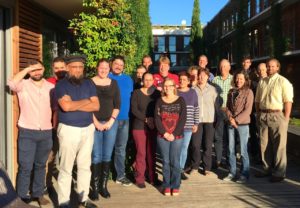
After a rainy start to the week, the sun finally came out on Thursday and provided an opportunity for an outdoor class photo (top). You can tell that we’re all having trouble looking towards the tremendously bright, southern France sun. The weather made for a great travel day to end the class on.

Rasmus Bro is shown introducing Parallel Factor Analysis (PARAFAC) to the class (bottom) in the Intro to Multi-way Analysis course module. Rasmus also did a module on Variable Selection, while Sébastian Preys covered Multi-block Models for Data Fusion. We also covered Clustering and Classification in addition to our introductory block of basic classes.
Many thanks to Sylvie Roussel, President of Ondalys, Cécile Fontange and Sandra Aubert for help with the local arrangements: you really made things easy for us! We really enjoyed the Marriott Courtyard, which provided a convenient location, modern conference and sleeping rooms, and delicious group lunches (I especially enjoyed the foie gras and lamb shank). We’re seriously considering return to Montpellier again next year–details to come!
Thanks to all our participants, many of whom travelled great distances to join us. This included students from across Europe and also from the United States and Australia. We trust your new chemometric skills will serve you well!
BMW
Another EigenU Europe Complete
Oct 9, 2015
The Fifth Eigenvector University Europe ran October 5-8 at the FOSS Innovation Centre in Hillerød, Denmark. Rasmus Bro and I really enjoyed the group. Everybody came well prepared (MATLAB and PLS_Toolbox installed and tested!) and loaded with questions. We covered basic chemometrics then moved on to more advanced topics.
Many thanks to the kind folks at FOSS, especially Lars Nørgaard, for use of the venue. The Innovation Centre is a beautiful facility. The coffee and snack service is great and I love lunches in the cafeteria!
Chemometrics, of course, is critical to FOSS’ success. At the heart of many of FOSS’ user-friendly application specific analyzers lies a very sophisticated calibration model. Lars leads what is possibly the largest chemometrics group in the world with a staff of about 30. We appreciate their support of the field!
We’re already starting to think about EigenU Europe for fall of 2016. We’d like to move south next year and are considering Italy, Spain or southern France. If you’ve got an idea for a venue write to me with details.
Good job class, and thanks for coming!
BMW
Top Ten Reasons to come to EigenU 2015
Apr 1, 2015
If you are in the market for training in multivariate methods you have a number of choices. In North America, you could attend classes given by CAMO, ProSensus, or Umetrics. Here are 10 reasons you should come to the 10th Annual EigenU 2015, May 10-15 in Seattle, instead:
- More experienced instructors – Courses at EigenU 2015 will be led by the EVRI staff including Neal B. Gallagher, Jeremy M. Shaver, Robert T. Roginski, and Willem Windig, plus our Associate Rasmus Bro, and of course myself. Plus this year’s special guest Johan Westerhuis will lead the second edition of our Chemometrics in Metabolomics course. Together we’ve got over 100 man-years of chemometric experience.
- Wider variety of courses – In addition to our beginning track including PCA and PLS, we offer 11 advanced and specialty courses. This year we’re introducing three new courses: Hierarchical and Optimized Models, Multi-block, Multi-set, Multi-level and Data Fusion Methods, and Classical Least Squares Methods. Calibration Model Maintenance returns this year, as does the popular Bring Your Own Data (BYOD) Workshop where you work with your own data while you learn hands-on with EVRI’s team of instructors.
- Method-centric instruction – At EigenU we provide the background required to truly understand chemometric methods; we don’t just show you what buttons to push. Our goal is to make the literature in the field accessible to our graduates. Deeper understanding of the methods leads to better analysis!
- Beautiful Seattle, WA – With Puget Sound and the Olympics to the West and Lake Washington and the Cascades to the East, the Emerald City is distractingly scenic. Plus, it is home to the Space Needle, Pike Place Market, Seattle Art Museum, Seattle Mariners (home games May 8-10, & 12-15), the largest ferry system in the US, plus tons of other attractions.
- The Washington Athletic Club – EigenU is held at the WAC, the nation’s premier city athletic club. The historic 21 story facility includes 5 floors of fitness facilities, 10 floors of Euro-styled techno-centric sleeping rooms, full service spa, and 3 restaurants.
- The food – From the continental breakfast, including the WAC’s signature sticky buns, through the gourmet plated lunches, to afternoon snack bars, our guests always rave about the food.
- Networking – EigenU attendance is typically about 40 scientists and engineers with a range of chemometric expertise and wide variety of interests. This means you’ll have plenty of opportunity to find colleagues with common problems and complementary solutions.
- Evening events – EigenU provides ample opportunity to continue your chemometric learning and networking into the evening. This includes Tuesday’s PLS_Toolbox/Solo User Poster Session, Wednesday’s PowerUser Tips & Tricks Session, and Thursday’s Workshop Dinner, which is one more opportunity to enjoy the WAC’s fabulous food. Present a poster at the Tuesday evening User Session and you could win a pair of Bose Noise-cancelling Headphones or Bluetooth Wireless Speaker!
- Flexible, multi-platform software – With PLS_Toolbox and MIA_Toolbox EVRI offers the most comprehensive set of chemometric tools available plus the flexibility of MATLAB. Our stand-alone packages Solo and Solo+MIA offer all the point and click tools of their MATLAB-based siblings. Plus they’re all available for Windows, Linux and MacOS. On-line tools Solo_Predictor and Model_Exporter provide a plethora of options for automating model application.
- Costs less – In spite of all its advantages, EigenU actually costs less than similar courses from CAMO, Umetrics and ProSensus.
So it probably isn’t surprising that EigenU attendees are more than satisfied. Here’s what a couple of them had to say:
“I attended the Eigenvector University 2010 earlier this year. It was the best short-course I have ever taken on any subject. I highly recommend it if you’re looking for a short-course, immersion kind of training.” – James M. Roberts, GSK
“What you are offering here is unmatched.” – David A. Russell, Dupont.
Discount registration ends soon, register and pay by April 10 for the best prices.
See you at EigenU!
BMW
EigenU 2014 Poster Contest Winners
Mar 2, 2015
Each year, Tuesday evening at Eigenvector University features the PLS_Toolbox/Solo User Poster Session. Prizes are given for the two best posters as judged by the Eigenvector staff, associates, and guest instructors.
At EigenU 2014 there were 10 posters presented by users, plus a couple more from EVRI, which made for a very lively session. Associate Rasmus Bro and guest lecturer Age Smilde, (who was there to lead the “Chemometrics in Metabolomics” course), assisted the Eigenvectorians in choosing the best posters. The winners were Eric Massicotte of the Canada Border Services Agency (CBSA) and Sarah Nielsen of Janssen Supply Group.
Massicotte displayed “Determination of the Geographic Origin of Tobacco Leaves by NIR.” A Partial Least Squares Discriminant Analysis (PLS-DA) model based on the NIR spectra of flue-cured tobacco leaves was developed that classified the samples into the 10 countries of origin. The sensitivity and specificity of the model was found to be greater than 0.92 for all classes except the USA group, which has the largest variability. The technique may be used in the future as a screening tool by the CBSA.
Nielsen presented “Distribution Analysis of Components in the EVRA® Patch by Confocal Raman Microscopy” which she developed with her co-author Amber Mantz. Confocal Raman Microscopy (CRM) images were generated at various locations within EVRA® samples to charaterize drug product and excipient distributions. PLS models were developed to predict relative drug concentration in the patches. Samples were analyzed from time of manufacture to product expiry to determine if changes in drug concentrations occurred. The models indicated that there were no significant changes over the life of the product.
Nielsen and Massicotte each received an Apple iPod nanos engraved with Eigenvector University 2014 Best Poster for their efforts. Good work, and thanks to everybody that presented at EigenU 2014!
BMW
Classical Least Squares (CLS) with Nonlinear Spectra
Oct 20, 2014
In the last several years we’ve seen a resurgence of interest in Classical Least Squares (CLS) modeling. To address that our Neal Gallagher is developing a course on CLS Methods for the next EigenU. Our interest also stems from the fact that we’ve worked on a number of consulting projects where CLS models are appropriate for calibrating spectroscopic systems. As you might expect, these systems are relatively simple mixtures in gas or liquid phase. Recall the CLS model is
X = CS‘ + E
where X is the measured spectra, C is the matrix of concentrations, S is the pure component spectra and E is noise.
Complicating matters a bit, several of the systems we’ve worked with exhibit significant nonlinearities due to high absorbance features. In spite of that, CLS models can work quite well if set up correctly. What follows is an example that demonstrates this (which I originally did just to clarify how this works in my own mind).
Suppose you have a single component system with a pure component response that is a simple Gaussian peak centered in the spectral range with a maximum value of one when the concentration is also one. Furthermore, suppose that the spectra is linear up to an absorbance of one but rolls off after that. (For xideal > 1 I used xmeasured = 2-exp(-(xideal-1)) but the exact form of the nonlinearity isn’t critical.) The measured spectra for concentrations from 0 to 3 is shown below, with concentration = 1 shown as the thick blue line. It is apparent that the shape changes as the concentration exceeds 1.
If the concentration is estimated using the ideal (concentration < 1) response, the estimate will fall below the actual value as the concentration passes 1, as shown below. If the spectral residuals were observed it would be apparent that there was a problem, but how to fix it?
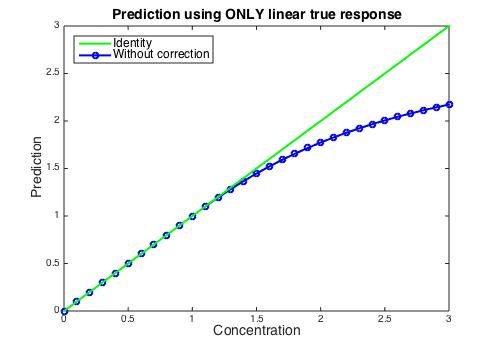
If the ideal response for each concentration is estimated, then the difference between it and the observed response can be calculated, as shown in the top panel in the figure below. Because each difference spectra has a slightly different shape, the rank of this difference matrix is equal to the number of samples exhibiting non-linear behavior, which in this case is 20 (the samples with concentration 1.1 to 3). However, it is easy to get a basis for the nonlinear deviations using the Singular Value Decomposition (SVD). Furthermore, the singular values indicate that 93.7% of the residual sum of squares is captured in the first factor, and 98.6% is captured in the first two. The ideal response along with the first two basis vectors is shown lower panel.
When the CLS model is augmented with the two basis vectors, the prediction improves dramatically. The figure below shows the predicted concentration of the analyte as well as the “concentration” of the two additional basis vector factors. The correction added by the 1st nonlinear factor becomes quite large at high concentrations, whereas the contribution of the 2nd nonlinear factor remains relatively small. The prediction error in the concentration of the analyte is less than 1%.
In a future blog post we’ll explore some other aspects of CLS models.
BMW
Eigenvector Starts 20th Year
Jan 6, 2014
On New Year’s day 2014 Eigenvector Research, Inc. (EVRI) celebrated its 19th birthday and began its 20th year. The momentum that carried us into 2013 built throughout the year and resulted in our largest year-over-year software sales increase since 2007. Our best three software sales months ever have all been within the last five months. Clearly our partnering with analytical instrument makers and software integrators plus our tools for putting models on-line are striking a responsive chord with users.
The consulting side of our business also continues to be very busy as we assist our clients to develop analytical methods in a wide variety of applications including medical, pharmaceutical, homeland security (threat detection), agriculture, food supplements, energy production and more.
The third leg of our business, chemometrics training, continued unabated as we taught on-site courses for government and industry, courses at conferences and held the 8th edition of our popular Eigenvector University (EigenU). We enter 2014 firing on all cylinders!
Major additions to PLS_Toolbox and Solo in 2013 included the Model Optimizer, Hierarchical Model Builder, a new Artificial Neural Network (ANN) tool, and several new file importers. We will soon release an additional ANN option along with new tools for instrument standardization/calibration transfer. Also on the horizon, a major new release of Solo_Predictor will include an enhanced web interface option and additional instrument control and scripting options.
2014 includes a busy schedule with conferences, talks, conference exhibits and short courses. Below is a listing of where you’ll be able to find us:
- January 21-24, IFPAC, Arlington, VA. BMW to present “Mixed Hierarchical Models for the Process Environment” and “A Multivariate Calibration Model Maintenance Road Map.”
- March 2-6, Pittcon Chicago, IL. NBG and RTR will be at the EVRI exhibition booth.
- April 27-May 2, EigenU 2014, 9th Annual Eigenvector University, Seattle, WA. Join the complete EVRI staff for 6 days of courses and events.
- May 6-9, EuroPACT, Barcelona, Spain. BMW to give plenary address “Model Maintenance: the Unrecognized Cost in PAT and QbD” and a condensed version of our “Chemometrics without Equations” short course.
- June 1-4, CMA4CH, Taormina, Italy. JMS to teach short course and talk TBD.
- June 8-12, CAC-XIV, Richmond, VA. NBG and RB to teach “Advanced Preprocessing for Spectroscopic Applications” and “Alternative Modeling Methods in Chemometrics.”
- August 2-8, IDRC, Chambersburg, PA. NBG to attend, talk TBD.
- September 14-18, ICRM, Nijmegen, The Netherlands. NBG to give keynote “An Overview of Hyperspectral Image Analysis in Chemometrics.”
- September 28-October 3, SciX 2014, Reno, NV. JMS Chemometrics Section Chair, talks and courses TBD.
- November 10-13, EigenU Europe, Hillerød, Denmark. Courses led by BMW and Eigenvector Associate Rasmus Bro.
- November 17-19, EAS 2014, Somerset, NJ. EVRI sponsor of Award for Achievements in Chemometrics. Courses and talks TBD.
We’re especially excited about this year’s Eigenvector University. This ninth edition of EigenU will include all our usual events (poster session, PowerUser Tips & Tricks, workshop dinner) plus five new short courses. Special guest Age Smilde will lead “Chemometrics in Metabolomics” and Rasmus Bro will present “Modeling Fluorescence EEM Data.” The other three new courses are “Calibration Model Maintenance,” “PLS_Toolbox Beyond the Interfaces” and “Getting PLS_Toolbox/Solo Models Online.” We expect EigenU 2014 to be an especially fun and fruitful learning experience.
We look forward to working with you in 2014!
BMW
Chemometrics Training and QbD
Jun 13, 2013
Emil W. Ciurczak wrote a nice blog post for PharmaEvolution claiming that the weak link in QbD is a lack of adequately trained chemometricians. I enjoyed his article, Chemometrics: The Weak Link in QbD, and I agree wholeheartedly with the conclusion that “the need for correct and in-depth chemometrics training is necessary for a successful PAT program.” But I don’t see how this is reconciled with “The title and spirit of this brief educational brochure from one vendor are right on target.” Anything that is “For Dummies” almost surely cannot be “in-depth.” And while I applaud the vendor for coming up with the concept, (and I’d say I wish we’d thought of it except we did think of it and the result is our CWE-Chemometrics without Equations courses) there isn’t much real information in the brochure. For instance Chapter 4 on classification is just 3 pages, one of which is just a list of applications.
The fact that chemometrics remains the weak link iin QbD is disappointing but it certainly isn’t for lack of effort on our part. We’ve taught hundreds of classes and thousands of students but a fairly small fraction of those are from pharma. From our business point-of-view, but also as a consumer of pharma products, I’d be happy to see more effort go into developing staff with chemometrics expertise. I do appreciate that it is, for many people, rather challenging subject material. We have put great effort into making chemometrics accessible. But I resist the urge to dumb it down too much.
An often used analogy is that most people don’t know how their mobile phone works but they are still able to use it, and chemometrics should be just as easy. But, unlike cell phones, chemometric tools aren’t being used by consumers, they are part of the process for producing things like mobile phones. And drugs. As such, their use and misuse has consequences. And while I’m happy to introduce people to chemometrics with our CWE courses and think attendees gain a useful level of proficiency and understanding of the techniques involved, I would prefer that those involved in QbD and pharma manufacturing acquire a deeper level of mastery. (To this end we provide our Eigenvector University courses, the next instance of which is EigenU Europe this October.) In order to understand a system’s limitations and how it can fail, you really need to understand how it works. You’re not going to get that at the “Dummies” level.
I very much appreciate Emil’s continued efforts to enlighten pharma as to the critical role of chemometrics. But, like me, does he sometimes feel as though he is pushing a string? I was struck by the registration process for PharmaEvolution website when you had to select your company’s business. There was a very long list of possibilities, but the closest thing to what we do was the very generic selection “engineering.” I still get the feeling that many in pharma (and certainly in some other industries) think of chemometrics as something that you do AFTER you’ve decided everything else and have started to take data. Thank-you, Emil, for your efforts to make it the integral part of the system that it must become.
BMW
EigenU Poster Session: Apple iPad mini and iPod nano ordered
Apr 29, 2013
Each year at Eigenvector University we host a PLS_Toolbox/Solo User Poster Session and User Group Meeting. This is a fun event as it gives our users a chance to show what they have been doing with our tools. It is also a chance for them to relax, have a beverage, and give us input on upcoming versions of our software.
This year’s EigenU Poster Session will be Tuesday, May 14, at 6:00 at the Washington Athletic Club. PLS_Toolbox and Solo users will showcase their own chemometric achievements and share results and remaining problems with other users and the EigenU instructors. We’ll also have a brief User Group Meeting where attendees can see what’s in the future of Eigenvector software development and give their input and feature requests.
The poster session and user group meeting will include complimentary beverages and hors d’oevres. This year’s Best Poster grand-prize is an Apple iPad mini (32GB). The runner up will receive an Apple iPod nano. Judging will be done by the EVRI staff. Attendance at the poster session is free and open to all EigenU attendees and Eigenvector software users. You need not attend classes at EigenU to come!
If you would like to present your work, please send a title and brief abstract to bmw@Eigenvector.com. Please be sure to describe how PLS_Toolbox, Solo or our other software products were used in the work.
See you there!
BMW
Chemometrics Q&A at FOSS Video
Jan 28, 2013
We have developed a collaboration with FOSS where we teach an open chemometrics course at their World Headquarters in Hillerød, Denmark, each fall. During our last course, the FOSS folks asked if I would do an interview for their NIRPerformance.com website. The website is a resource for Feed industry professionals who work with Near Infrared (NIR) spectroscopy.
The interview is a little bit slanted towards NIR users but contains some good general information about our courses, consulting and general chemometrics philosophy. In the video I answer the following questions about chemometrics and our courses:
- Whom are your chemometrics courses for?
- How much of an NIR solution is based on chemometrics?
- What does the average NIR user need to know about chemometrics?
- What are the trends in chemometrics today?
- How will your course attendees use their training in chemometrics?
Our next big training event is Eigenvector University 2013. This 8th Annual EigenU runs May 12-17 in Seattle. We have a number of other training opportunities in 2013, including courses in the UK, Spain and France. See our schedule for details. We also plan to be back at FOSS for EigenU Europe this October.
BMW
Find Jeremy Shaver at EAS Next Week
Nov 8, 2012
Eigenvector’s Chief of Technology Development Dr. Jeremy Shaver is getting ready to head off to the Eastern Analytical Symposium (EAS). He’ll be busy on Sunday and Monday assisting Eigenvector Associate Dr. Don Dahlberg with Chemometrics without Equations (CWE). As I wrote previously, this year the popular CWE is being extended by a day to cover advanced data preprocessing. Jeremy will be demonstrating the methods using the recently released PLS_Toolbox/Solo 7.0. If you’d like to attend, there is still time to register through the conference web site!
Jeremy will also represent EVRI at the session honoring Professor Dr. Lutgarde Buydens of Radboud University Nijmegen for Outstanding Achievements in Chemometrics. The award is, once again, sponsored by Eigenvector Research. The award session, chaired by University of Barcelona’s Dr. Anna de Juan, will start Monday morning at 9:00am.
You might also find Dr. Shaver at the Cobalt Light Systems Ltd booth. Cobalt, one of EVRI’s Technology Partners, develops tools for non-invasive analysis. Their TRS100 pharmaceutical analysis instrument utilizes our Solo software for chemometric modeling. Jeremy will be there to advise users on how to best calibrate the system for their particular needs.
Of course, if you can catch him, Jeremy would be happy to talk to anyone interested in EVRI’s software offerings! He’s the Eigenvectorian most intimately familiar with our products and their features and capabilities. Drop Dr. Shaver an email if you’d like to meet him at EAS.
Have a good week!
BMW
Thanks to FOSS!
Oct 25, 2012
Rasmus Bro and I wrapped up another short course today, this time at FOSS World Headquarters in Hillerød, DENMARK. We’d like to thank our students, another great group, and especially our host at FOSS, Lars Nørgaard, Senior Manager of FOSS Team Chemometric Development. Lars makes it easy for us to hold this course as the meal and coffee service arrangements are all done through the excellent FOSS Canteen, and they also provide a very comfortable classroom.
This was our second year at FOSS, and we’re planning on making it a regular thing, our Eigenvector University Europe. Next year we’ll be in FOSS’ new “Innovation Centre,” due to be completed this winter. We’re certain it will provide a great venue for EigenU Europe, 2013. Exact dates are TBD, but we’re looking once again at the last half of October.
Thanks again to the kind folks at FOSS!
BMW
Chemometrics without Equations Extended at EAS
Oct 17, 2012
The popular Chemometrics without Equations (CWE) series will be extended at the Eastern Analytical Symposium (EAS) this year with the addition of a second day, CWE II. While the original CWE focuses on the basics of Principal Components Analysis (PCA) and Partial Least Squares (PLS) regression, CWE II will explore advanced data preprocessing methods and mixture analysis.
I have been known to say that the secret to getting good regression models is what you do before the data hits the modeling algorithm. Preprocessing methods attempt to remove extraneous variance so that the variance of interest can be more easily modeled. When done correctly, preprocessing can greatly improve model performance. CWE II covers the whys and hows of data preprocessing with examples from several methods.
Also covered in CWE II, Mixture analysis techniques, such as Multivariate Curve Resolution (MCR) aka Self-Modeling Mixture Analysis (SMMA), can elucidate the true underlying physical roots of the data, e.g. pure component spectra and chemical concentrations. As such, these methods can lead to better fundamental understanding of the systems involved.
The courses will be led by Dr. Don Dahlberg, Emeritus Professor at Lebanon Valley College. Don will be assisted by EVRI’s Chief of Technology Development Dr. Jeremy M. Shaver.
The courses will be held Sunday and Monday, November 11 and 12, at the Holiday Inn in Somerset, NJ. Registration is handled by EAS. Complete course information can be found in EAS’s Short Course Schedule and Description.
BMW
Off to SCIX 2012 in Kansas City
Sep 25, 2012
EVRI will have a strong presence at SCIX 2012 (formerly FACSS) next week, September 30 to October 5. Eigenvectorians Jeremy Shaver, Bob Roginski and Randy Bishop will be busy teaching, speaking and representing Eigenvector.
EVRI is offering two hands-on short courses at SCIX: Chemometrics without Equations (CWE) and the follow-on Advanced Chemometrics without Equations (ACWE). CWE will be presented as a two-day course, September 30-October 1 (Sunday-Monday), while ACWE is one day, October 3 (Wednesday). Jeremy, Bob and Randy will be tag-teaming as instructors, so participants will get a chance to interact with all three of them. They each have abundant experience in the field of chemometrics, but somewhat different perspectives, so it should make for lively courses. Registration can be done on-site.
As usual, EVRI will be involved with the Technical Sessions. At 2:20 Monday afternoon Jeremy will present “Data Sampling for Extending the Life of NIR-based Models” in Chicago C. This talk deals with the problem of updating models using historical (non-designed) data. Methods for selecting data subsets are compared relative to the goal of improving the model while minimizing costs. Bob will present the poster “Target Detection Applied to Detection of Adulterants in Powdered Raw Material using Near Infrared Hyperspectral Imaging” at the Wednesday morning poster session in the Exhibit Hall. An application of detecting melamine in wheat gluten is shown.
The Exhibit opens Monday evening with a reception from 5:30 to 7:30. This is always a fun event, so be sure to stop by Booth 47 for your complimentary Eigenvector Bottle Opener. The Exhibit is also open Tuesday 9:00-4:30 and Wednesday 9:00-4:00. The Eigenguys will be demoing the upcoming PLS_Toolbox and Solo version 7, to be released this fall.
Jeremy will also represent Eigenvector on the panel of the Student Free Lunch and Employment Discussion on Tuesday.
It will be a busy week. Have fun, Jeremy, Bob and Randy!
BMW
By Popular Demand: EigenU Online
Jun 22, 2012
At the last several editions of Eigenvector University (aka EigenU) our beginning track courses have been consistently overbooked. This includes the first three days of courses consisting of Linear Algebra for Chemometricians, MATLAB for Chemometricians, Chemometrics I: PCA, and Chemometrics II: Regression and PLS. There were also EigenU attendees with schedule conflicts that made it impossible for them to attend some of these courses, but they needed the background to attend other EigenU courses.
Therefore, due to popular demand, we’ve created EigenU Online. EigenU Online allows users to get chemometrics training on their own schedule and at their own desk. The material covered is the same as in their EigenU counterparts. Courses consist of video lectures using both slides and software demonstrations, plus course notes in .pdf format. Additional materials and data sets are included for some courses.
The goal of the EigenU Online courses is to provide students the background they’ll need to understand the chemometric methods presented and accomplish typical modeling tasks in PLS_Toolbox and Solo. But, like our EigenU courses, they aren’t just about using software! No matter whose software you use, you’ll be a better user after EigenU Online.
We’ve made a couple segments of our online courses available free for your evaluation. Just login to your Eigenvector account, or create one. Under the EigenU Online tab you’ll see a link to the lecture Classical Least Squares – Introduction, and to Classical Least Squares – Hands-on Example which shows how the course software demonstrations work.
For complete information, see the EigenU Online page. Still have questions? Write to me at bmw@eigenvector.com.
BMW

 SEARCH
SEARCH